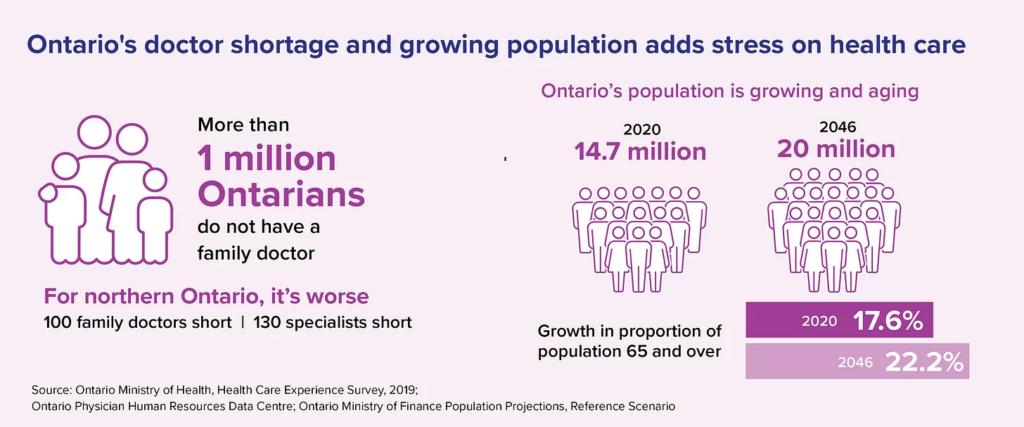Brace for impact.
In my home province of Ontario, we are facing a crisis in primary care. A few statistics from the Ontario Medical Association’s 2023 report on primary care:
- 2.2 million Ontarians do not have a family doctor, according to new research by the INSPIRE PHC research group.
- This number will likely grow. Four in 10 physicians of all specialties surveyed by the OMA said they were considering retiring over the next five years.
- New data released today by the Ontario College of Family Physicians shows two-thirds of family physicians are planning to make a change to their practice model, reduce their hours or retire in the next five years.
- Data suggests medical students aren’t interested in becoming family doctors. Across Canada, more than 100 residency spots in family medicine went unfilled for 2023. No other specialty had more than two spots left unfilled.
The report paints a grim picture. With more than 2 million Ontarians without a family physician, that number is bound to swell as our population continues to grow. The healthcare exodus, originally fueled by burnout from the pandemic, is set to continue as many physicians and other practitioners contemplate retirement or switching industries. With a tsunami of demand on the horizon, there’s grave uncertainty about if our healthcare system will be able to stay afloat.

Drowning From Demand
As a frontline healthcare worker, I’ve witnessed firsthand the deterioration of our healthcare system. Long wait times for specialists and surgical backlogs have left patients feeling abandoned. To make matters worse, we’re grappling with a mental health crisis and epidemic of preventable chronic disease, negatively impacting all ages and socioeconomic backgrounds.
Let’s look for example, at at non-communicable diseases (NCDs). A recent paper in the The Lancet Global Health presented data on the economic impact and costs of physical inactivity. The authors project that by 2030, almost 500 million new cases of preventable NCDs and $520 billion in global healthcare costs. To add fuel to this fire, consider our aging population. According to Ontario Population Projections, by 2045, Ontario will have 20 million people. The percentage of our population over the age of 65 will jump from 17% today to 22% in 2045.

The math is clear: our population is growing and aging at an unprecedented rate. The clock is ticking, and the pressure is mounting, much like the surging waters of a tsunami. To meet the impending healthcare demands, we must take action today. It’s not just about treating illness when it arises; it’s about preventing disease in the first place. We need to incentivize our system to have a more dynamic approach, focused on primary prevention and education.
Chronic Disease Prevention
Here are three crucial pointers on how we can build a sturdy dam against the approaching tsunami of healthcare demand:
1. Education Campaigns for Healthy Habits
We must invest in educational campaigns targeting younger patients, and promoting and rewarding healthy habits and behaviors. If we can encourage people to implement habits of regular physical activity, proper nutrition, stress management, and sleep hygiene, we can create a potential bulwark against the oncoming wave of chronic diseases.
2. Workplace Wellness Programs
Businesses can play a pivotal role by implementing workplace wellness programs. These initiatives not only improve employee health but also bolster resilience against the healthcare tsunami. By creating healthier work environments, we can create stronger communities.
3. Digital Health Solutions
In our technology-driven era, we can harness the power of digital health solutions to stay afloat amidst the rising tide of healthcare demand. Promote the adoption of telehealth services, health apps, and wearable devices that enable individuals to monitor their health proactively. These digital tools not only facilitate early symptom detection but also empower individuals to take charge of their well-being, reducing the burden on our healthcare system.
Bottom Line
In healthcare, we are currently standing on the shore, bracing for an upcoming tsunami. The challenges of an aging population and a strained primary care system cannot be ignored. We must shift our focus from treating diseases to preventing them. By implementing education campaigns, workplace wellness programs, and fostering innovation in the field of health technology, we can build a fortified barrier against the oncoming healthcare tsunami.
The time for change is now, and it begins with each of us advocating for a healthcare system that champions preventive medicine.
Thanks for reading.
P.S. If you or anyone you know is interested in coming off their meds or learning more about deprescribing, click on “Work with Shawn” at the top of the site, or you can fill out the form below to contact me directly.
May you be happy and healthy.
SG

